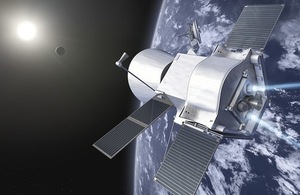BepiColombo
This EuropeanEuropean/Japanese Space Agency mission to Mercury will help our understanding of the formation of the Solar System and its inner rocky planets.


Artist's impression of the BepiColombo satellite.
Overview
BepiColombo is a joint mission between the European Space Agency (ESA) and Japan Aerospace Exploration Agency (JAXA), with significant UK involvement.
The BepiColombo spacecraft:
- was launched on 20 October 2018
- is currently in cruise phase towards its destination
- is due to arrive at Mercury in late
20252026 - is a joint mission between Europe and Japan
- has key UK involvement
Introduction
Almost as dense as the Earth but not much bigger than our Moon, Mercury is the second smallest planet in the Solar System; scientists believe Mercury’s high density can be put down to the planet having a massive iron core.
The surface is pock-marked with enormous craters caused by meteorites smashing into the planet’s surface in the early stages of the Solar System’s evolution some four billion years ago.
BepiColombo will be only the third spacecraft to visit Mercury in the history of space exploration. The mission will increase our understanding of all aspects of the planet, from its composition, structure, atmosphere and magnetic environment.
Mercury’s harsh environment makes it a particularly challenging mission. The spacecraft will have to endure intense sunlight and temperatures up to 350°C while gathering data.
BepiColombo is named after Giuseppe ‘Bepi’ Colombo (1920-1984), a scientist who studied Mercury’s orbital motion in detail as well as orbits and interplanetary travel in general. Although the temperature on Mercury can go as high as 462°C, the side of the planet facing away from the Sun is always very cold. One of the key objectives for BepiColombo is to find out whether there is ice on the cold side of the planet.
The mission will build on the experience gained in using electric propulsion on the SMART-1 mission. BepiColombo’s journey will also be helped by the gravity of the Moon, Earth and Venus during fly-bys to help it on its way to Mercury. It will take the BepiColombo spacecraft seven years to reach its destination.
Technology
BepiColombo consists of four sections: a Mercury Transfer Module (MTM) - designed to get the spacecraft to the planet; two orbiters: the European Mercury Planetary Orbiter (MPO) and the Japanese Mercury Magnetospheric Orbiter (MMO); and a sunshield and interface structure (MOSIF) to protect it during the cruise phase.
ESA is responsible for the larger MPO. Its 11 scientific instruments will study Mercury from a low-polar-orbit.
MIXS will measure fluorescent X-rays that come from the Sun and are reflected off the planet’s surface. Fluorescent X-ray measurements can be used to identify chemical elements while measurements at infrared wavelengths can be used to determine mineral composition.
Japan developed the MMO. This has five science instruments on board designed to examine Mercury’s magnetic field and magnetosphere - the magnetic ‘bubble’ surrounding a planet. Mercury intrigues scientists because it is hard to understand why such a small planet can have a magnetic field at all.
BepiColombo will make its way to Mercury with an ion engine. This employs solar panels to generate electricity which is used to produce charged particles from xenon gas. A beam of these charged particles, or ions, is then expelled from the spacecraft. The engine will be used to slow the spacecraft down so that it can eventually be captured by the gravity of Mercury.
UK involvement
Key items of the spacecraft were built in the UK in partnership with several UK science teams. The UK’s involvement in BepiColombo is funded by the UK Space Agency.
UK space scientists, led by the University of Leicester, developed one of the key instruments on board BepiColombo: MIXS (Mercury Imaging X-ray Spectrometer). MIXS will be used to help find out about what the planet’s surface is made of. This will help to explain how the planet formed during the early history of the Solar System.
Airbus Defence and Space (Germany) was appointed as the prime contractor to build the European components. Airbus UK provided all the spacecraft structures as well as the electrical and chemical propulsion systems for the MTM, the chemical propulsion system for the MPO (which will be the first dual mode propulsion system designed and built in Europe) and the systems which will separate the spacecraft modules on arrival at Mercury.
QinetiQ (UK) was awarded the contract to supply the innovative electric propulsion system for BepiColombo. Electricity generated by solar panels will be used to produce charged particles from xenon gas. A beam of these charged particles, or ions, is then expelled from the spacecraft to propel it forward. Ion propulsion produces low levels of thrust very efficiently compared with conventional chemical rockets.
SEA Ltd (now Thales Alenia Space UK) was contracted to supply the Remote Interface Units (RIU’s) for the MPO and the MTM. The RIU’s are important equipment for both spacecraft as they acquire the critical sensor data and telemetry as well as driving the thrusters that control the spacecraft.
Updates to this page
Published 25 April 2014Last updated
-
Updated arrival date.
-
Updated July 2022.
-
Page updated to reflect current mission status.